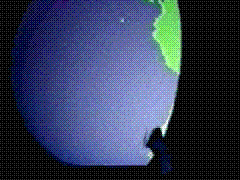Tsunamis are unlike wind-generated waves, which many of us may have observed on a local lake or at a coastal beach, in that they are characterized as shallow-water waves, with long periods and wave lengths. The wind-generated swell one sees at a California beach, for example, spawned by a storm out in the Pacific and rhythmically rolling in, one wave after another, might have a period of about 10 s and a wave length of 150 m. A tsunami, on the other hand, can have a wavelength in excess of 100 km, 15 m height and period on the order of one hour.

As a result of their long wave lengths, tsunamis behave as shallow-water waves. A wave becomes a shallow-water wave when the ratio between the water depth and its wave length gets very small. Shallow-water waves move at a speed that is equal to the square root of the product of the acceleration of gravity (9.8 m/s2) and the water depth - let's see what this implies: In the Pacific Ocean, where the typical water depth is about 4000 m, a tsunami travels at about 200 m/s, or over 700 km/h. Because the rate at which a wave loses its energy is inversely related to its wave length, tsunamis not only propagate at high speeds, they can also travel great, transoceanic distances with limited energy losses.